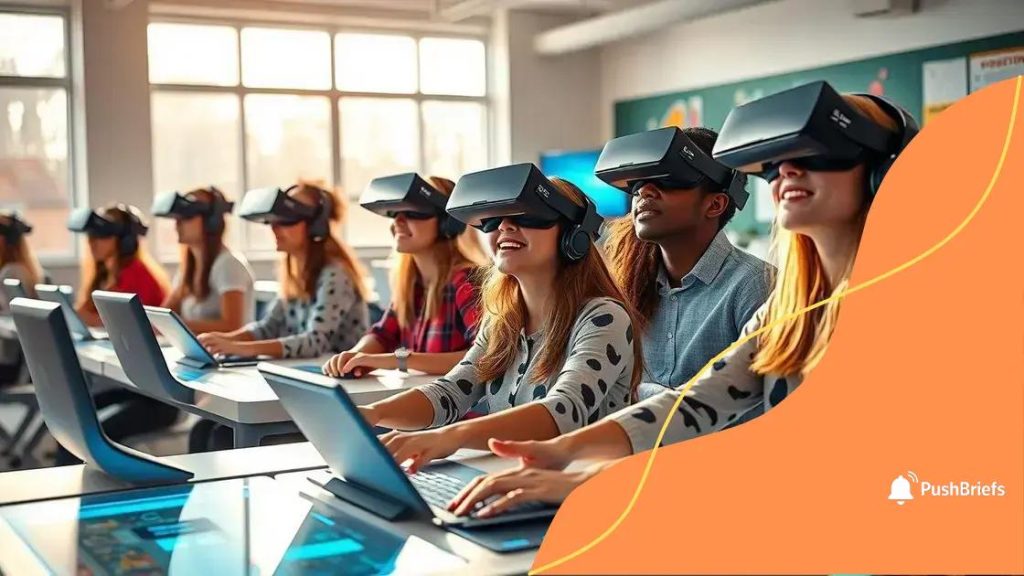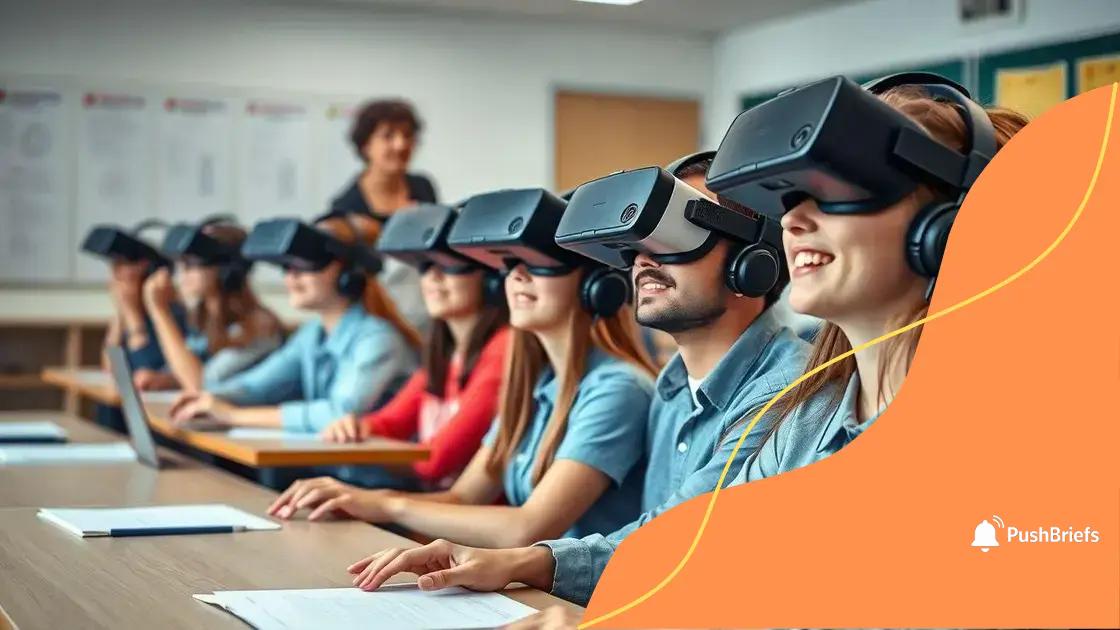Virtual reality in higher education: transforming the learning experience

Virtual reality in higher education enhances learning by providing immersive experiences, increasing engagement, and catering to diverse learning styles, while facing challenges like costs and accessibility.
Virtual reality in higher education is reshaping how students learn and engage with their subjects. Imagine stepping into a historical event or exploring the human body in 3D. This article dives into these possibilities and what they mean for learners today.
Understanding virtual reality technology
Understanding virtual reality technology is vital for grasping its applications in education. This advanced tech creates immersive experiences, allowing students to interact with their learning materials in dynamic ways. By wearing a headset, learners can step into different environments, gaining insights that traditional classrooms may not offer.
Key Components of Virtual Reality
To effectively utilize virtual reality, it’s essential to understand its main components. These include:
- Hardware: This comprises VR headsets, sensors, and controllers that detect movements.
- Software: Educational programs and simulations designed specifically for VR environments.
- Content Creation: Developing engaging scenarios that enhance learning experiences.
Each component plays a significant role in how users engage with the virtual world. For instance, the hardware must be high-quality to ensure smooth experiences and minimize motion sickness.
The software available for virtual reality spans various subjects. From exploring distant planets in astronomy to diving into the depths of the ocean in marine biology, these programs can significantly enrich the learning process. Imagine students not just reading about historical events but actually experiencing them.
Benefits of Virtual Reality in Learning
One of the exciting aspects of virtual reality technology is its ability to cater to various learning styles. Visual learners can see complex ideas in 3D, while kinesthetic learners can touch and interact with virtual objects. By engaging multiple senses, students retain information better.
Moreover, virtual reality fosters collaboration. Students can work together in a shared virtual space, regardless of their physical locations. This not only enhances peer learning but also prepares them for a globalized world.
Benefits of virtual reality in education
The benefits of virtual reality in education are profound and far-reaching. This innovative technology is changing how students learn and engage with complex subjects. By creating immersive environments, virtual reality allows learners to experience concepts firsthand.
Enhanced Engagement
One major advantage of virtual reality is increased student engagement. Traditional teaching methods can sometimes lead to boredom. However, when students interact with VR, they often become more invested in the learning process. For example, exploring a historical site or experimenting in a virtual chemistry lab can spark curiosity.
- Interactive Learning: Students can manipulate 3D models, making learning more hands-on.
- Real-world Applications: VR prepares students for real-life scenarios, enhancing their skills.
- Diverse Learning Styles: Everyone learns differently, and VR accommodates various learning preferences.
Furthermore, virtual reality technology can bridge the gap for students who may struggle in conventional learning settings. Providing visual and experiential learning opportunities can help students grasp difficult concepts more easily. For instance, a student who finds math challenging might excel when using VR to visualize problems in a 3D space.
Building Empathy and Understanding
Another important benefit is that virtual reality fosters empathy and understanding. Through simulations, students can step into different roles, experiencing challenges faced by others. This can lead to greater awareness and compassion.
Imagine a student participating in a VR experience that places them in the shoes of a person from a different culture. This exposure can promote inclusivity and encourage respectful discussion about diverse perspectives.
Ultimately, the benefits of virtual reality in education are extensive. By enhancing engagement, accommodating diverse learning styles, and fostering empathy, VR can create a richer and more impactful educational experience for all students.
Implementing virtual reality in classrooms

Implementing virtual reality in classrooms can be a game-changer for education. By integrating this technology, teachers can provide students with rich, engaging experiences that enhance learning. The process of adopting virtual reality may seem daunting, but with clear steps, it becomes manageable and effective.
Steps to Implementation
The first step in implementing virtual reality is understanding the available resources. Schools need to assess what technology they already have and what additional tools are necessary. This often includes VR headsets and compatible software. Budgeting is also crucial to ensure that the school can acquire the needed equipment without financial strain.
- Training Educators: It’s essential to provide training for teachers. Understanding how to use VR technology effectively will ensure that students benefit from it.
- Curriculum Development: Teachers should incorporate VR into the existing curriculum. This can include lessons on science, history, and even art. The key is to align VR experiences with learning objectives.
- Creating a Safe Environment: Setting up a dedicated space for VR in classrooms can help create a safe environment for students to explore.
Once the necessary resources are in place, the next step is to pilot VR in a few classrooms. This approach allows educators to gather feedback and make improvements before a full-scale rollout. It’s important to evaluate how students respond to these lessons and adjust accordingly.
Overcoming Challenges
Implementing virtual reality is not without its challenges. One of the main concerns is ensuring that all students have equal access to the technology. Schools should strive for inclusivity and provide support for any students who struggle with the tech.
Another challenge is managing classroom time effectively. Teachers need to balance traditional lessons with VR activities. Thus, careful planning is vital to successfully integrate virtual reality into day-to-day lessons.
Ultimately, implementing virtual reality in classrooms offers an exciting opportunity for students to engage with learning material in a new way. From hands-on experiences to interactive simulations, VR can spark a passion for learning and create lasting educational memories.
Challenges of using virtual reality in higher education
The challenges of using virtual reality in higher education are significant and must be addressed for successful implementation. While the potential benefits are impressive, there are hurdles that educators and institutions must navigate to effectively integrate this technology.
Cost and Accessibility
One of the primary challenges is the cost associated with adopting virtual reality technology. Schools and universities need to invest in high-quality VR headsets and software, which can be expensive. Additionally, maintaining and updating this technology incurs ongoing costs. Many institutions may struggle to secure funding for these necessary resources, making it difficult to provide equal access to all students.
- Funding Limitations: Many educational institutions face tight budgets that limit their ability to explore new technologies.
- Equipment Maintenance: Equipment requires ongoing maintenance and updates, which can strain resources.
- Access for All Students: Not all students may have access to VR technology at home, leading to inequality in learning experiences.
In addition to cost, accessibility is another significant concern. Some students may experience motion sickness or discomfort while using VR. This can prevent them from fully engaging with the learning material. Additionally, those with certain disabilities may find it challenging to navigate virtual environments effectively.
Integration into Curriculum
Integrating virtual reality into the existing curriculum poses its own challenges. Educators need to develop lesson plans that utilize VR technology effectively while ensuring they align with educational standards. This requires a significant amount of time and effort, which can be overwhelming for teachers already managing busy schedules.
Moreover, not all subjects lend themselves equally to VR integration. While fields like science and history can benefit from immersive experiences, other subjects may find it difficult to incorporate VR in meaningful ways. Training teachers to use this technology effectively is essential, but finding time for professional development is often a challenge.
Despite these challenges, many educators believe that overcoming these obstacles is worth the effort. The unique experiences that virtual reality can offer promote engagement and understanding among students. With the right support and resources, the potential of VR in higher education is vast.
Future trends in virtual reality for education
The future trends in virtual reality for education promise to change how students learn and engage with content. As technology continues to evolve, educators are finding new ways to leverage VR to enhance the classroom experience.
Increased Accessibility
One trend is the increasing accessibility of virtual reality tools. More affordable options are becoming available, making it easier for schools to incorporate VR into their curriculum. New advancements in mobile VR technology mean that students can explore virtual worlds even on their smartphones. This flexibility makes it more feasible to use VR in a variety of educational settings.
- Cost-Effective Solutions: Companies are developing solutions that reduce hardware costs, allowing schools to implement VR without breaking the bank.
- Software Innovations: New platforms are offering customizable VR experiences tailored to specific subjects and learning outcomes.
- Mobile VR Options: With the rise of mobile VR, students can engage with content outside the classroom, promoting independent learning.
Another trend in the future of virtual reality in education is the use of gamification. Educational VR experiences are increasingly being designed as games, motivating students to learn in a fun and engaging way. Students can earn rewards and achievements as they master new concepts, making learning more attractive.
Virtual Reality in Remote Learning
As remote learning becomes more common, virtual reality is stepping in to bridge the gap. VR allows students who are learning from home to have interactive experiences that mimic in-person learning. They can collaborate with peers in virtual environments, participate in group discussions, and take part in immersive lessons.
Furthermore, enhancing emotional intelligence is emerging as a relevant trend. Virtual reality can create situations where students experience scenarios that develop empathy, such as understanding the challenges faced by individuals from diverse backgrounds. This approach can strengthen social skills and foster compassion among students.
Overall, the future trends in virtual reality for education look bright. With innovations aimed at improving accessibility, gamification, and the potential to enhance remote learning, VR is set to play a crucial role in reshaping the educational landscape.
In conclusion, virtual reality holds incredible potential for transforming education. By enhancing engagement and providing immersive experiences, it can change how students learn and interact with course material. Future trends indicate that as technology becomes more accessible and integrated into curricula, VR will play a crucial role in shaping the educational landscape. While challenges exist, the benefits of using virtual reality in classrooms are undeniable. As we look forward, embracing this technology can open new doors for motivation, understanding, and collaboration among students.
FAQ – Frequently Asked Questions about Virtual Reality in Education
What are the main benefits of using virtual reality in education?
The main benefits include enhanced engagement, immersive learning experiences, and the ability to cater to different learning styles.
How can virtual reality improve remote learning?
Virtual reality can create interactive experiences that mimic in-person learning, allowing students to collaborate and engage with content effectively from home.
What are some challenges of implementing virtual reality in classrooms?
Challenges include high costs, the need for teacher training, and ensuring equal accessibility for all students.
What trends are shaping the future of virtual reality in education?
Future trends include increased accessibility of VR technology, gamified learning experiences, and its application in developing emotional intelligence.
